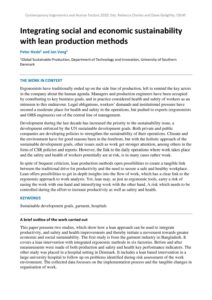| Document | Author Peter Hasle and Jan Vang |
| Abstract Ergonomists have traditionally ended up on the side line of production, left to remind the key actors in the company about the human agenda. Managers and production engineers have been occupied by contributing to key business goals, and in practice considered health and safety of workers as an intrusion to this endeavour. Legal obligations, workers’ demands and institutional pressure have secured a moderate place for health and safety in the operations, but pushed to experts (ergonomists and OHS engineers) out of the central line of management. Development during the last decade has increased the priority to the sustainability issue, a development enforced by the UN sustainable development goals. Both private and public companies are developing policies to strengthen the sustainability of their operations. Climate and the environment have for good reasons been in the forefront, but with the holistic approach of the sustainable development goals, other issues such as work get stronger attention, among others in the form of CSR policies and reports. However, the link to the daily operations where work takes place and the safety and health of workers potentially are at risk, is in many cases rather weak. In spite of frequent criticism, lean production methods open possibilities to create a tangible link between the traditional drive for productivity and the need to secure a safe and healthy workplace. Lean offers possibilities to get in-depth insights into the flow of work, which has a clear link to the ergonomic approach to work analysis. Yet, lean may, as just as ergonomic tools, carry a risk of easing the work with one hand and intensifying work with the other hand. A risk which needs to be controlled during the effort to increase productivity as well as safety and health. |

